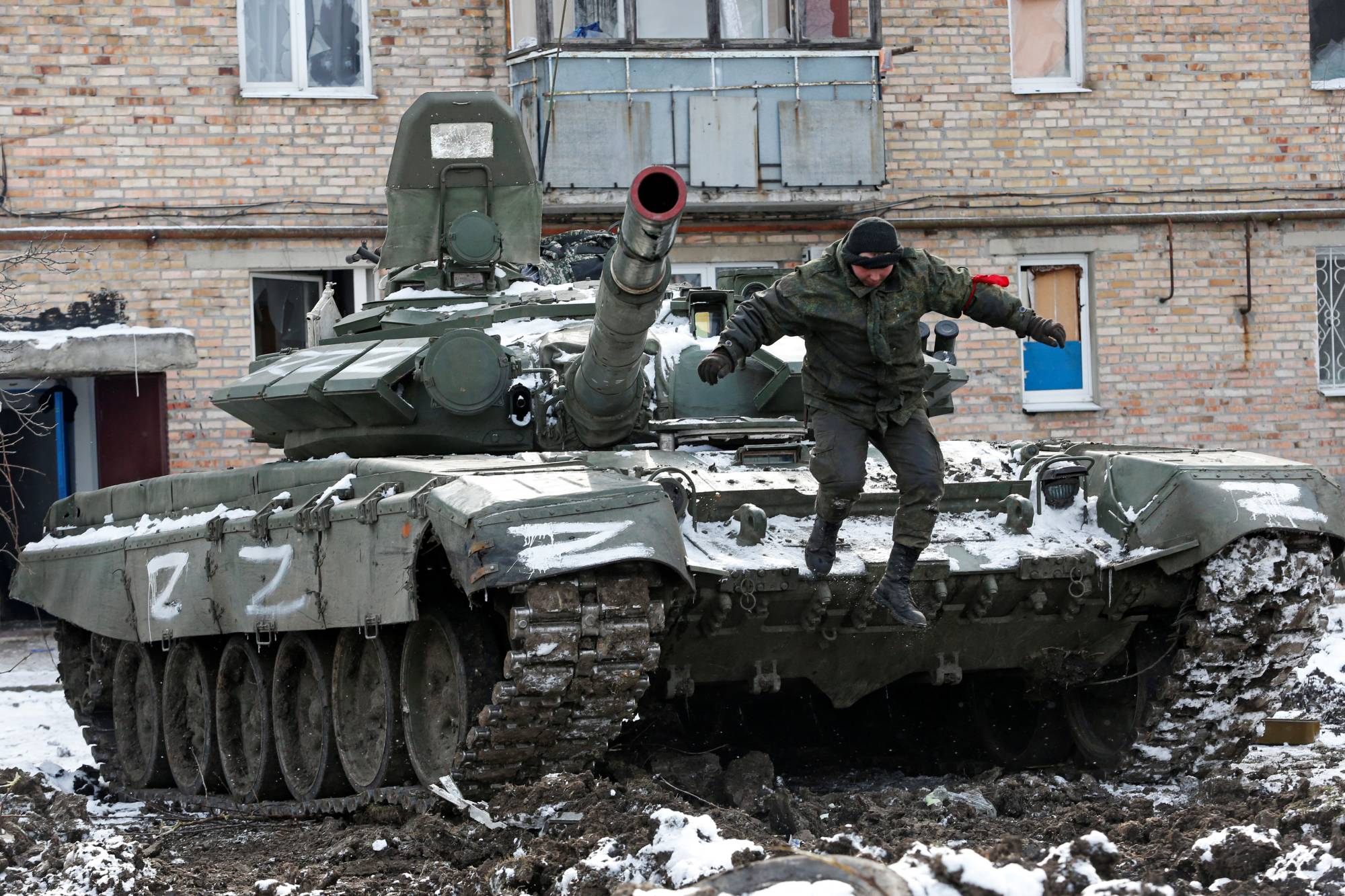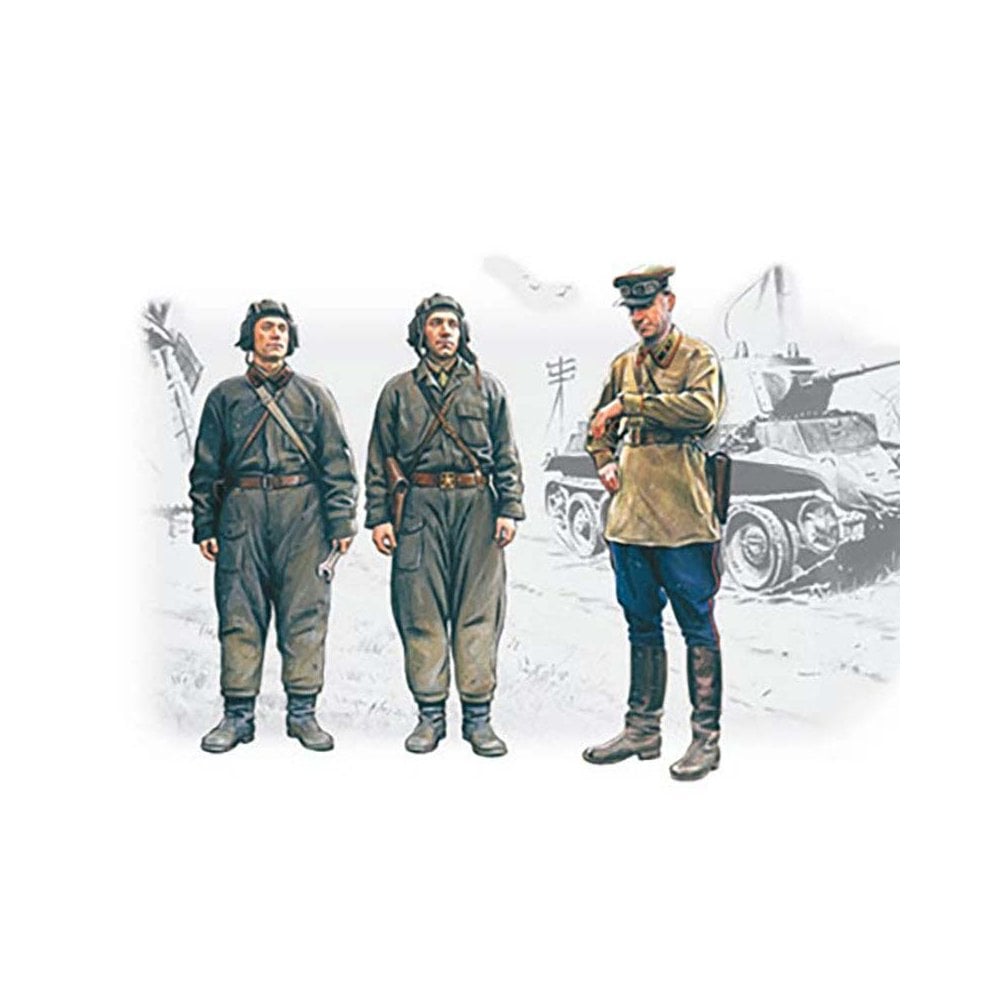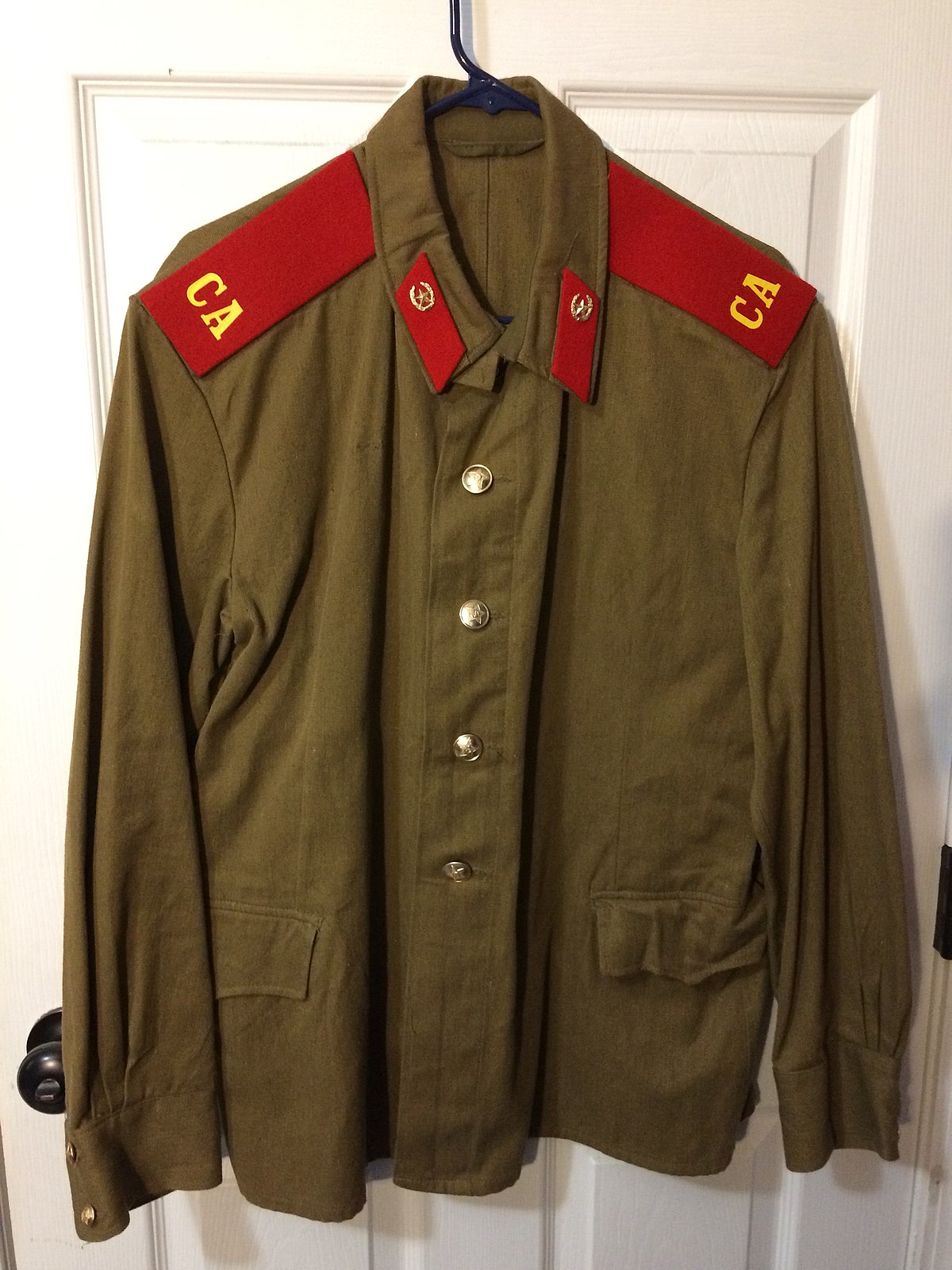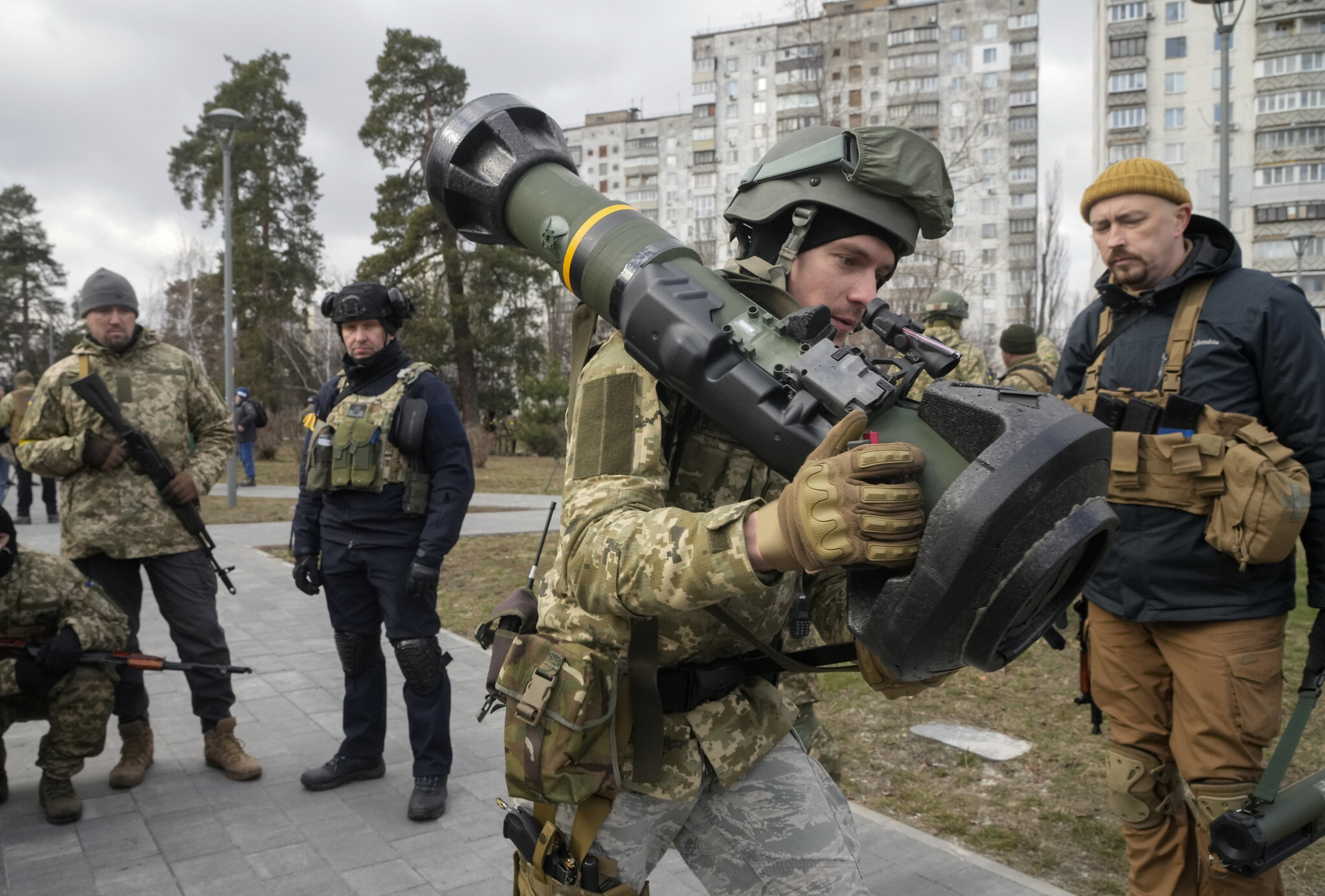Russian Tanker Uniform – This was due to the fact that the first Red army tanker wraps (jackets) were originally made out of the same black-coated (fire resistant) leather (the ones also originating from 1931) which was later (during the late 1930s) abandoned in favor to
common cotton or canvas-made black one-piece coveralls (as seen on the photo to the right), because of which the helmet material was also changed from leather to canvas and generally remained so until the present day.
Russian Tanker Uniform

A group of Soviet tankers at rest beside their T-62A tank in Eastern Siberia, May 1975. They are all wearing the winter version of the early/black suit model, distinguished by jacket featuring detachable fur lining around the collar, paired with TSh-
4M-Z helmets (winter version, also featuring the fur-filled insides). 3D model featuring standard appearance of Soviet army tank commander from 1949 until 1972, still wearing the distinctive Red army one-piece-black coveralls from photo above and older model of popular Sapogi jackboots, but using the first model of the TSh-4M helmet,
which featured electronics (the intercom set), as was thus intended for Soviet Cold-war era tanks (the MBT’s), which all featured radio. The TT pistol was soon replaced with new PM in 1951, while regular tankers received AKMS automatic rifles starting from 1959. These one-piece black coveralls where continued to be used as far as 1972 when they were finally phased out in favor to very similar,
but two-piece suits (see photo below). TSh-4M helmet as featured in 1970s Soviet propaganda poster celebrating the tanker’s day (День танкистов – Den tankistov), which was from 1946 to 1980 marked every 11th June and since 1980 until today every first Sunday in September and which still continues to do so
nowadays, in modern Russia, Ukraine and Belarus. In contrast to the mentioned infantry camouflage patterns and uniforms, (which were continued to be extensively used by the newly formed Russian and most other post-Soviet armies as far as early 2010s), the khaki model of tanker’s suit was almost immediately discontinued from both
usage and production after the breakup of USSR and was first replaced with another model of the existing suit (now featuring TTsKO or, then new, VSR camouflage pattern). Soon later, those models too were completely phased-out in favor of common infantryman’s uniform (from 1998 also featured in then new, Flora camouflage pattern)[23][24][25], thus largely eliminating the difference in appearance of tankers and
infantry (except the headwear) in the Russian Armed Forces (up until 2011), which was always present in the Soviet army. The second model of TSh-4M directly served as a basis for Soviet paratrooper helmet, known as ДШ (DŠ/DSh, meaning Desantnij Šlem/Desantniy Shlem, translated as; Airborne helmet), also popularly called Прыжковый шлем (Prižkovij šlem/Prizhkoviy shlem
, meaning; Jump helmet). It was developed directly from TSh-4M and made its first appearance among Soviet paratroopers (VDV) during the late 1970s. Basically, it was just a standard TSh-4M helmet with only distinctive ear coverings removed (due to having its headset removed) and replaced with airholes on each side.
Also, in contrast to the original TSh-4M, it was produced mainly in cotton instead of the usual canvas and did not feature standard black but distinctive khaki appearance instead (current Russian army versions are now being produced in their newest EMR digital pattern camouflage)
.[4] Among enthusiasts and collectors, the early/first model (ТШ-4) is nowadays colloquially known as either Red Army or somewhat incorrectly as WWII model (since it appeared almost ten years before the outbreak of the war), the second and third (ТШ

-4М) are known either as the Cold war or Soviet Army model, while the latest one (same designation) is commonly known as Russian Army or as the Modern model (although it originally appeared during the early 1980s, that is, back in the Soviet
times). However, the biggest change was in the introduction of the everyday/service version of M-88 (often popularly nicknamed Afganka, due to being originally introduced to personnel involved in the Soviet-Afghan war), which was made in distinctive khaki pattern and which finally
replaced the previous and already obsolete M-69 uniform (which was until then, often used even as battledress). Summer versions featured an integrated belt on the trousers while the winter ones had it on the jacket. Because of that and due to being heavier, the winter trousers included belt loops instead, intended for pulling through the standard Soviet army brownish leather belt with metallic buckle (featuring a red star decorated with hammer and sickle) or the standard Soviet officer’s belt with a
double buckling piece. [17][18] In case of tanker’s equipment, those belts served only for carrying the usual Soviet canvas magazine pouch on it[19][20] (intended for three AKM or AK-74 spare magazines). Despite the fact that the originally Soviet Tankoviy kostum is again returned to usage in the modern Russian army, many Russian tankers and vehicle crewmen in general are never officially using the EMR digital pattern or other infantry camouflage uniforms[43][44][45]
[46][47] (but mostly the SPG, SPAAG and Armata crewmen), so the Tankoviy suit is today for use exclusively restricted only for crewmen of their currently used MBT’s (T-72, T-80 and T-90) and IFV’s/ICV’s (BMP-2 and BMP-3).
Modern Russian tankers wearing the latest/dark-blue version of Tankoviy kostyum, which also features a new tank patch (now depicting a stylized T-90 instead of previous T-62), paired with newest model of TSh-4M headset and standard- issue gas-mask bags across their shoulders.
The late/khaki model of Tankoviy kostum makes an appearance in this T-80BV MBT demonstration video from the GDR in the late 1980s. The suit is seen worn by the T-80 crewmen in a few occasions – at 0:28, 2:05, 4:08 and 12:17.
As mentioned back during the introduction section, the first and the earliest variant of the Soviet tank helmet appeared back in 1931, when the Soviet Red army started acquiring its first tanks (most notably the T-24 and then T-26 as well as famous BT
series of light tanks). The TSh-4 is easily distinguished from the later and much more common models (TSh-4M), since it was severely different in its design. Firstly, it was originally made out of genuine (calfskin) black-coated (sometimes brownish) leather, although the later and more common TSh-4 variants (starting from the 1940s) switched to canvas.
Following a decree No. 92 issued directly by the Soviet Ministry of Defense starting from 27th April 1972, the existing TSh-4M was severely redesigned, what will become the most iconic, widespread and popular model of all.
It was now distinguished by its distinctive four head-protecting, bulged-out longitudinal lines on the overhead part (two located in the middle along with one on each side of the overhead), compared to the previous three (as found in both previous versions

– the original Red Army one, as well as its preceding model). It also featured wider neck and again slightly longer backhead cover as well as thinner forehead-protection section. It retained the same R-124 intercom system (twin laryngophones together with plug and earphones) built-in and was produced and officially used by all Army vehicle operators as well as certain Navy personnel from 1972 until 1983.
The Tankoviy costume also makes a brief appearance in this 1980s Soviet army promo video, featuring their popular song Mi – Armiya Naroda (We – Army of the People). The suit is seen on T-72 crewmen at 0:45 and again at 1:30.
The M-69 service uniform and KLMK camouflage coverall can also be observed here. However, exactly due to these issues, both the summer (shirt) as well as the winter (jacket) versions of the suit included an internal pistol pocket (another feature not found in the previously used coverall), intended for standard-issue PM (
Pistolet Makarova), which ensured that it could be always carried. Artist Ronald Volstad impression of standard Soviet army tanker appearances from early 1970s until late 1980s (from Osprey title Inside the Soviet Army). All are wearing their distinctive two-piece black suits, paired along with the newest (second) model of TSh-4M helmets and Sapogi jackboots.
As of early 2010s, the Russian Armed Forces faced their newest modernization program pursued under the policies of the current Defense minister Sergej Šojgu (Sergey Shoygu, on English alphabet) and General staff chief Valerij Gerasimov (Valery Gerasimov).
This modernization, among other new technology, weaponry and equipment, firstly saw the introduction of the new parade uniforms for all branches (similar to the ones worn by the old Russian Empire officers), as well as the new Ratnik (literally; Warrior) program,
which, among many other features, introduced the all-out new EMR pattern (the Russian first digital camouflage uniform) as a replacement for the Flora pattern (itself a replacement for previously used VSR), which was officially used from 1998 until 2011 as the
standard camouflage of the Armed Forces. Moreover, the suit now also features additional, anti-infrared layers on the existing fire-resistant material, which severely lowers the possibility of spotting its wearer via thermal devices (as an example, the feature is very useful when crewmen have to abandon the
disabled vehicle in the middle of the firefight).[42] The appearance of the redesigned TSh-4M was actually marked together with the appearance of the then newly introduced two-piece tanker’s suits (the Tankoviy kostum) as a replacement for previous one-piece suits (Tankoviy kommunos), retaining the same (black) pattern.
Both of these (helmet and suit) being results of the Soviet Army’s modernization program of the period, which lasted through the few years, and which, among other new technology, introduced the new service uniform (the M-69), headgear (the SSh
-68 combat helmet), firearm (AK-74 automatic rifle) and so on. Russian tankers gathered around dismantled NSVT heavy machine gun, wearing the summer version of the suit paired along with standard infantryman’s EMR digital-pattern field cap (for everyday use), as the newest alternative to the usually worn beret.

Behind them is a T-90M Proryv, currently the newest model of T-90 tank. The changing of the color (from black into khaki) of the tanker’s suit during 1980s marked the final change of appearance of Soviet and previously Red Army tankers after almost fifty years, since they officially wore the all-out black suits/coveralls from late 1930s
until early 1980s (although, the Red Army tankers often unofficially wore either light-grey, brown or dark-blue colored coveralls during WWII, but that was exclusively an alternative which appeared due to severe shortages of the black-colored textile).
T-80 crewmen installing/repairing its track piece during training exercise, late 1980s. Like on the previous photo, they are all wearing the summer version of the later/khaki suit along with the latest TSh-4M-L helmets, but here combined with tanker’s full-combat equipment;
each issued with an AKS-74U carbine along with a separate (leather) belt featuring a canvas magazine pouch and a gas-mask bag over the shoulder (either GP-5 or GP-7). Despite being in production and usage far longer than any of the previous models (for almost 40 years – originally since 1983), this model is actually much rarer and harder to find as well as significantly less widespread on the market.
This however, should not surprise at all, since this model (as being the latest variant) is currently in use by tankers of various armies throughout Europe and the world, which explains why it is not so common on the military surplus markets, at least
when compared to its predecessor. This also simultaneously explains why the previous version (second model of TSh-4M) is much more popular and widespread on the market even nowadays, despite being produced much shorter and significantly longer time ago.
The modernized model (ТШ-4М) also introduced the winter variant, which is designated as the ТШ-4М-3 (TSh-4M-Z). The capital letter 3 (Z) in Cyrillics stands for Зимний (meaning; Zimnij/Zimniy and translated as Winter) and is characterized by featuring the fur lining inside.
Due to the introduction of the winter model, the existing summer variants are specified as the ТШ-4М-Л (TSh-4M-L), hence their capital letter Л (L) stands for Летний, meaning Letnij/Letniy (Summer). Three tank commanders (officers) behind a BMP-1, discussing movements with mechanized infantry during an exercise, late 1970s.
They are also wearing the usual summer black version of the suit along with a standard TSh-4M-L headset and a map/document case. The two infantrymen are wearing the KLMK one-piece camouflage coveralls, paired with standard SŠ-68 (SSh-68) steel combat helmet along with artificial foliage.
However, this version is often also known alternatively known as ШШ-1 (ŠŠ-1/ShSh-1), meaning Noise-reducing Headset, exactly due to having additional noise-reducing layer built inside earphone housings, which also explains its visibly larger ear coverings when compared to the preceding model, as previously mentioned.
It was serially produced and officially used by all Red Army tankers up until the late 1940s and beginning of the Cold war period, which means it was commonly used during the entire World War II and in all Soviet (light, medium and heavy) tanks of

that period, among others, the famous KV-I and T-34 medium tanks, as well as IS-II heavy tank. It also featured a redesigned backhead cover, which was slightly lengthened in order to provide mounting for the then newly introduced Soviet tanker’s night vision device, the PNV-57 (Прицел Ночного Видения), translated as PNV-57 (Pricel Nochnogo Videnija/Pritsel Nochnogo Videniya)
, meaning Night-vision sight, which was intended specifically for TSh-4M series of helmets. Reason due to which the PNV-57 could be used exclusively with TSh-4 series of helmets, lies in fact that the mounting pins of its battery housing (which is mounted on the back side of the goggles) was designed to be attached onto the
middle of the distinctive, three bulged-out longitudinal-protective lines on the helmet’s overhead. The same practice was also followed in its successor model. The first or earlier (black) model of the suit was in serial production and official usage by Soviet tankers for eleven years (from 1972 until 1983) and was thus used in all of their tanks of the period;
from T-55 and T-62 through T-64 and T-72 up until T-80, when it was replaced with literally the same model, but only of different color (appearance). However, the original (black) model was nonetheless unofficially continued to be occasionally used and even produced as far as the late 1980s, which contributed to the generally very slow process of swapping the old equipment and uniforms with new ones in the Soviet armed forces.
This was actually pretty regular for such a huge force (counting more than a few million men in active service and as fivefold as that in addition/reserve) as the Soviet army was. The earliest model, originally designated ТШ-4, made its first appearance back in the interwar period (during the early 1930s), when then the Soviet Red Army began to equip itself with their first armored vehicles (tanks) and was continued to be produced through World War
II up until the end of the 1940s and the beginning of the early Cold War period. Then, it was replaced with a severely redesigned and modernized model (featuring built-in intercom) in then recently renamed Soviet Army, now designated as ТШ-4М (М standing for Modernizirovannij/Modernizirovanniy, simply meaning Modernized) which was continued to be produced
through almost the entire Cold war era and early 1980s, when it was, after the breakup of USSR, completely replaced with only slightly redesigned and still current model used by Russian Army, which, however, retained the same (ТШ-4М) designation.
In case of footwear, it was still paired with distinctive and even then very popular Sapogi leather-made jackboots, which were back then issued to and used by almost all Soviet Armed Forces personnel (even for battledress/combat uniforms).
Although often being described as the latest and the modern Russian Army model, it was in fact originally still issued to the Soviet tankers during the 1980s, together with new, khaki version of already existing and mentioned Tankoviy kostum (replacing the original, black ones) but
was most probably first widely-observed on T-80U crewmen of the elite Tamanskaja (Tamanskaya) armored division during the failed 1991 Coup d’etat in Moscow’s Red Square[5], which is nowadays often known as the so-called August Coup. Following a 1982 decree issued from the Soviet Ministry of Defense, the Soviet Armed Forces faced another modernization program, which, among new technology, equipment and weaponry, also included new uniforms and appearance of various branches and units.
Although the Soviet tankers were officially always issued with an AKS-74U automatic carbine as their standard firearm and thus, the belonging pouch containing three spare magazines along with it, they almost never preferred to actually wear neither the rifle nor the pouch on them (along
with any other equipment – map case, gas mask bag and others), simply due to the fact that literally anything worn on them could seriously hinder them while getting in and out of the tanks through the hatches above, which were also severely narrow.
This was especially important if they had to quickly bail out when the tank was hit and burning, where literally every second could mean the difference between life and death.

Emma Nehls is a military writer and historian with a passion for exploring the intricacies of warfare and the human experience within the military. With extensive knowledge and a deep understanding of military strategy, tactics, and historical contexts, Nehls brings a unique perspective to his writings.